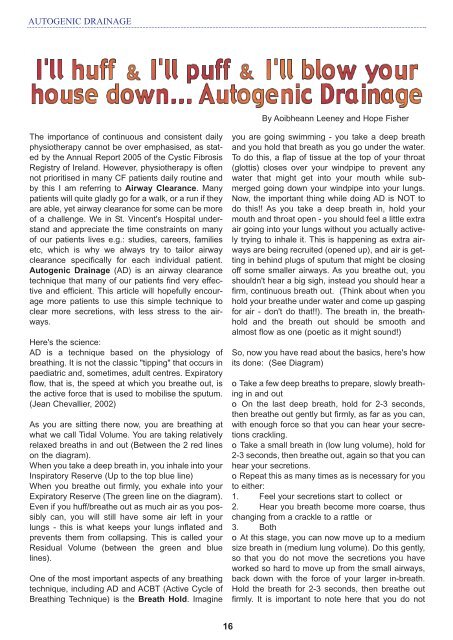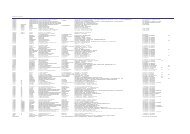E-INTERVIEW with Michael Cunningham - Cystic Fibrosis ...
E-INTERVIEW with Michael Cunningham - Cystic Fibrosis ...
E-INTERVIEW with Michael Cunningham - Cystic Fibrosis ...
Create successful ePaper yourself
Turn your PDF publications into a flip-book with our unique Google optimized e-Paper software.
AUTOGENIC DRAINAGE<br />
The importance of continuous and consistent daily<br />
physiotherapy cannot be over emphasised, as stated<br />
by the Annual Report 2005 of the <strong>Cystic</strong> <strong>Fibrosis</strong><br />
Registry of Ireland. However, physiotherapy is often<br />
not prioritised in many CF patients daily routine and<br />
by this I am referring to Airway Clearance. Many<br />
patients will quite gladly go for a walk, or a run if they<br />
are able, yet airway clearance for some can be more<br />
of a challenge. We in St. Vincent's Hospital understand<br />
and appreciate the time constraints on many<br />
of our patients lives e.g.: studies, careers, families<br />
etc, which is why we always try to tailor airway<br />
clearance specifically for each individual patient.<br />
Autogenic Drainage (AD) is an airway clearance<br />
technique that many of our patients find very effective<br />
and efficient. This article will hopefully encourage<br />
more patients to use this simple technique to<br />
clear more secretions, <strong>with</strong> less stress to the airways.<br />
Here's the science:<br />
AD is a technique based on the physiology of<br />
breathing. It is not the classic "tipping" that occurs in<br />
paediatric and, sometimes, adult centres. Expiratory<br />
flow, that is, the speed at which you breathe out, is<br />
the active force that is used to mobilise the sputum.<br />
(Jean Chevallier, 2002)<br />
As you are sitting there now, you are breathing at<br />
what we call Tidal Volume. You are taking relatively<br />
relaxed breaths in and out (Between the 2 red lines<br />
on the diagram).<br />
When you take a deep breath in, you inhale into your<br />
Inspiratory Reserve (Up to the top blue line)<br />
When you breathe out firmly, you exhale into your<br />
Expiratory Reserve (The green line on the diagram).<br />
Even if you huff/breathe out as much air as you possibly<br />
can, you will still have some air left in your<br />
lungs - this is what keeps your lungs inflated and<br />
prevents them from collapsing. This is called your<br />
Residual Volume (between the green and blue<br />
lines).<br />
One of the most important aspects of any breathing<br />
technique, including AD and ACBT (Active Cycle of<br />
Breathing Technique) is the Breath Hold. Imagine<br />
16<br />
By Aoibheann Leeney and Hope Fisher<br />
you are going swimming - you take a deep breath<br />
and you hold that breath as you go under the water.<br />
To do this, a flap of tissue at the top of your throat<br />
(glottis) closes over your windpipe to prevent any<br />
water that might get into your mouth while submerged<br />
going down your windpipe into your lungs.<br />
Now, the important thing while doing AD is NOT to<br />
do this!! As you take a deep breath in, hold your<br />
mouth and throat open - you should feel a little extra<br />
air going into your lungs <strong>with</strong>out you actually actively<br />
trying to inhale it. This is happening as extra airways<br />
are being recruited (opened up), and air is getting<br />
in behind plugs of sputum that might be closing<br />
off some smaller airways. As you breathe out, you<br />
shouldn't hear a big sigh, instead you should hear a<br />
firm, continuous breath out. (Think about when you<br />
hold your breathe under water and come up gasping<br />
for air - don't do that!!). The breath in, the breathhold<br />
and the breath out should be smooth and<br />
almost flow as one (poetic as it might sound!)<br />
So, now you have read about the basics, here's how<br />
its done: (See Diagram)<br />
o Take a few deep breaths to prepare, slowly breathing<br />
in and out<br />
o On the last deep breath, hold for 2-3 seconds,<br />
then breathe out gently but firmly, as far as you can,<br />
<strong>with</strong> enough force so that you can hear your secretions<br />
crackling.<br />
o Take a small breath in (low lung volume), hold for<br />
2-3 seconds, then breathe out, again so that you can<br />
hear your secretions.<br />
o Repeat this as many times as is necessary for you<br />
to either:<br />
1. Feel your secretions start to collect or<br />
2. Hear you breath become more coarse, thus<br />
changing from a crackle to a rattle or<br />
3. Both<br />
o At this stage, you can now move up to a medium<br />
size breath in (medium lung volume). Do this gently,<br />
so that you do not move the secretions you have<br />
worked so hard to move up from the small airways,<br />
back down <strong>with</strong> the force of your larger in-breath.<br />
Hold the breath for 2-3 seconds, then breathe out<br />
firmly. It is important to note here that you do not



